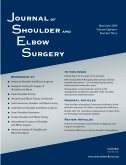
ARTHROPLASTY
Lateralized vs non-lateralized reverse shoulder arthroplasty: 2 year rotational function
This report has been verified
by one or more authors of the
original publication.
J Shoulder Elbow Surg. 2015 Sep;24(9):1397-404
34 patients with rotator cuff arthropathy were randomized to undergo either non-lateralized or bony increased offset lateralized reverse shoulder arthroplasty. The purpose of the study was to determine if rotational function differed between non-lateralized and lateralized arthroplasties up to 2 years post-operatively. Results found both surgical methods to be effective in restoring shoulder function, with no significant difference in external rotation or functional measures (CS, agCS, DASH, and ADLER tests). However, subgroup analysis removing patients with high fatty infiltration and atrophy of the teres minor revealed a significantly greater improvement to external rotation in the lateralized group compared to the non-lateralized group.
Unlock the full ACE Report
You have access to {0} free articles per month.Click below to unlock and view this {1}
Unlock NowCritical appraisals of the latest, high-impact randomized controlled trials and systematic reviews in orthopaedics
Access to OrthoEvidence podcast content, including collaborations with the Journal of Bone and Joint Surgery, interviews with internationally recognized surgeons, and roundtable discussions on orthopaedic news and topics
Subscription to The Pulse, a twice-weekly evidence-based newsletter designed to help you make better clinical decisions
Exclusive access to original content articles, including in-house systematic reviews, and articles on health research methods and hot orthopaedic topics
Or upgrade today and gain access to all OrthoEvidence content for just $1.99 per week.
Already have an account? Log in


Subscribe to "The Pulse"
Evidence-Based Orthopaedics direct to your inbox.
{0} of {1} free articles
Become an OrthoEvidence Premium Member. Expand your perspective with high-quality evidence.
Upgrade Now













































































